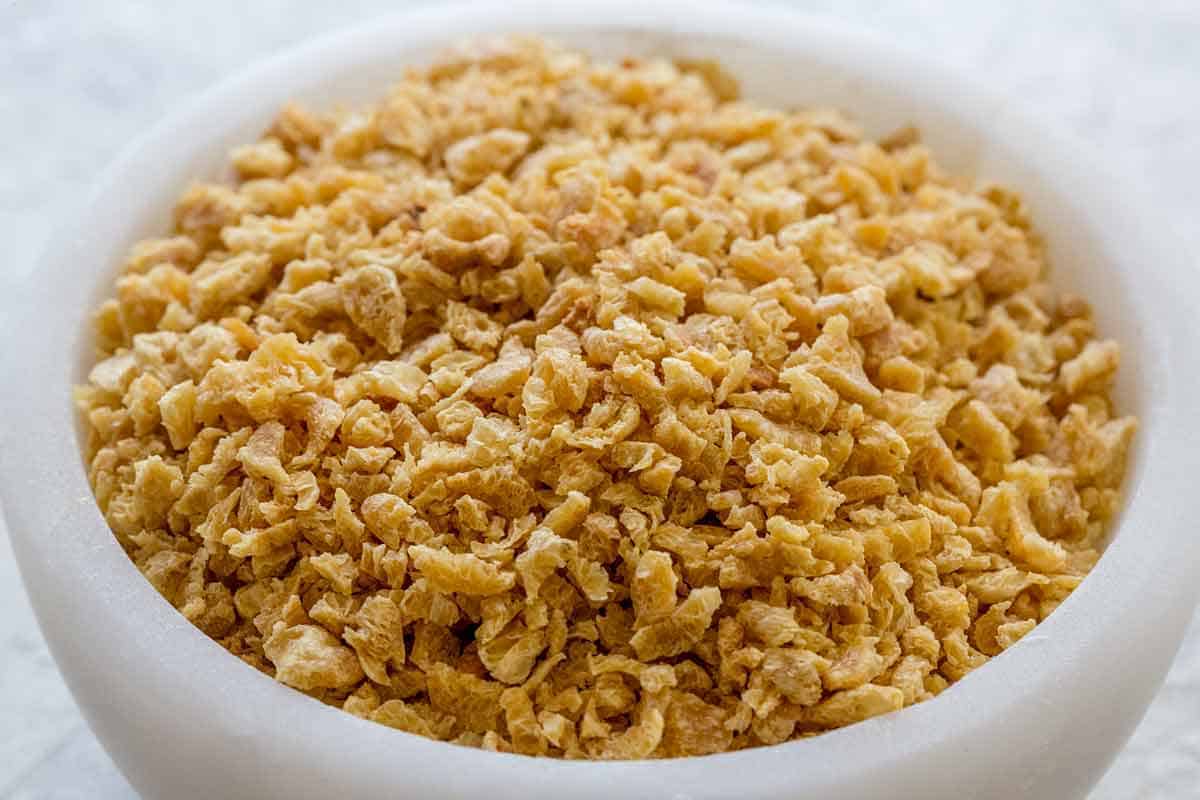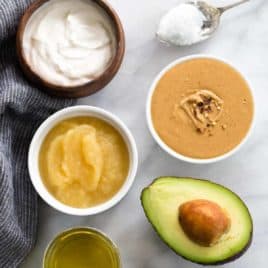There are a plethora of vegan protein sources available for those following a plant-based diet. Eating a combination of these foods daily can help provide complete protein and keep meals interesting.

Vegan protein sources are crucial for those on purely plant-based diets. The amino acids in proteins are the building blocks for muscles and tissues and assist with immune function, so consuming several protein-rich ingredients is critical.
It can be a challenge to obtain all of the nine essential amino acids from single types of plants alone. That’s why it’s necessary for those on a vegan diet to incorporate a variety of food sources that are high in protein and healthy fats to receive all the required nutrients for normal body function.
The good news is there are many tasty ways to enjoy vegan sources of protein, including nuts and seeds, soy products, legumes, and grains, which all vary in the amount of protein. This guide provides non-animal-based protein options, many of which are gluten-free, for those who live a vegetarian or vegan lifestyle or would like to incorporate more plants into their diet.
Beans

These inexpensive and versatile legumes are packed with protein and fiber. It takes a while to make them on the stovetop, but canned beans are an excellent convenience product when short on time. There are so many types of beans, the most popular being black bean, pinto, kidney, and cannellini. I love to add them to burgers, soups, stews, salads, tacos, and dips.
Chickpeas

Also referred to as garbanzo beans, this staple legume in the Mediterranean and the Middle East is a source of carbohydrates, protein, and fiber. Most often beige with a mealy texture and mild flavor, roasted chickpeas have become a favorite snack, but you can also find them in a couscous salad or homemade hummus. The liquid from canned garbanzo beans is often used as an egg substitute called aquafaba.
Lentils

Lentils are dried and vary in color and size. There are many types of lentils, including brown, green, Lentilles du Puy, red, yellow, and black, and they all have different textures and tastes. Learning how to cook lentils is easy, and each type lends itself well to soups, stews, sides, or salads.
Peas

Pea protein, especially in powder form, has become commonplace as a vegan and vegetarian source. You will often find it in protein powders. Eaten fresh, frozen, or canned, peas also have additional benefits as the nutrients and fibers are retained in the whole plant. They are easy to add to soups, stews, rice dishes, and more!
Soybeans

Globally, soybeans or soya beans are the most consumed food, and for good reason. They contain a significant amount of protein and provide all nine essential amino acids. These oval beige oilseeds are often used to make soy milk, tofu, tempeh, and textured vegetable protein.
Tofu

Tofu is made from soymilk by pressing the curds into solid slabs. The press time and the amount of coagulant and whey removed will result in different types of tofu: silken, soft, medium, firm, and extra-firm tofu textures. This soy-based high-protein source has a lightly sweet and nutty flavor and is versatile in many culinary applications. Baked tofu is a popular favorite, but it can be fried, marinated, grilled, sauteed, or stir-fried—the options are endless.
Edamame

Often used in Japanese cuisine, edamame is an immature soybean. It comes in its pods, and the green, tender beans can be enjoyed once boiled or steamed. An excellent protein snack, edamame can be added to soba noodle salad, sides, or stir-fries.
Tempeh

This rectangular-shaped pressed cake is made from fermented cooked soybeans. It often contains a mixture of grains with flavoring agents. However, soy-free versions are also available. It has a robust nutty flavor and holds its shape well during cooking. It can be marinated and used to make a stir fry, sandwiched, or cut in slabs to make seared or grilled steaks.
Textured Vegetable Protein (TVP)

These crunchy soybean flakes are used as a meat extender or vegetarian meat substitute. Stir them into mixes for tacos, chili, sandwiches, meatballs, or meatloaf. It’s a versatile gluten-free meat alternative.
Seitan

Also known as “wheat meat,” seitan is made from wheat gluten. The texture is very chewy, mimicking chicken or beef. Often sold in slabs, pre-cut slices, cubes, or pre-seasoned. Lends well to marinating, coating and fried, or stir-fried.
Bulgur Wheat

Bulgar is made from the golden grains of parboiled or steamed wheat kernels or berries. It’s then dried, with some of the bran removed, and further ground. The neutral-tasting grain cooks relatively quickly, depending on whether it’s medium or coarse ground. It should be rinsed before cooking to remove excess starches. It’s a popular grain used in tabbouleh.
Wheat Berry

Wheat berries are the whole kernels of wheat that have not been processed. They have a chewy texture and take longer to cook but provide proper nutrition. It can be added to salads, soups, or as a side dish.
Freekeh
This olive-green grain with nutty and smoky flavors is made from immature durum wheat. It has three times more fiber and two times more protein than white rice, rivaling quinoa in macronutrient profile. It can be purchased whole or cracked and boiled until tender. It’s often eaten in the eastern Mediterranean and North African cuisines, like salads and pilafs.
Barley

Barley is a nutty cereal grain famous for its use in beer making but can be eaten for its protein and fiber content. It can be purchased with its bran intact (hulled) or removed (pearled), which cooks quicker. It’s easy to add to salad, soups or a nice alternative to rice for risotto.
Oats

Many types of oats have soluble and insoluble fibers, and beta-glucans. They also have a balance of protein, fat, and carbs and are known as whole-grain food. They are sold as steel-cut that is partially cooked and cut into small rounds, old-fashioned, which are hulled, steamed, and pressed flat, or instant, which is precooked and dried. Eat them as a porridge, soak them for overnight oats as a ready-to-go breakfast, make oat milk, or add them to snacks like energy bites.
Rice

Depending on the types of rice you choose, there will be a different taste, texture and nutritional value. The rice grain is mainly endosperm and may contain the germ, bran, and husk if not removed. White rice is more tender because it has been husked, while brown rice still has not and takes longer to cook, but it has more nutrients retained. Long, medium, and short-grain rice are available that yield different textures when cooked. Red and black rice are also available that have additional antioxidants.
Amaranth
Amaranth is a gluten-free and protein-rich grain native to Peru. The fibers aid in digestion and the calcium helps with bone health. The nutty and toasted flavored grains and flour can be used in cooking. It’s boiled and simmered uncovered, about ½ cup amaranth to 1 ½ cups water. Use flour in baked goods, and grains in breakfast porridge, puddings, and as replacements for rice or other grains.
Farro

Farro is a nutty ancient grain that provides an excellent source of dietary fiber, protein, and iron per serving. When you’re ready to learn how to cook farro it can be boiled and then simmered until the grains are tender. It’s great to add to a farro soup, stews, risotto, or salads.
Quinoa

Quinoa is a superfood seed of the goosefoot plant from the Andes Mountains. It is one of the few plant-based proteins that provides all nine essential amino acids. The seeds have a nutty taste but should be rinsed before cooking to remove the slightly bitter flavor from their protective coating called saponins. They come in yellow, black, and red and are often mixed. You can cook quinoa like rice and add other flavors for a tasty side dish or use it in burgers or fritters.
Flaxseeds

Flaxseed health benefits include loads of fiber, protein, and omega-3 fatty acids, particularly alpha-linolenic acid. They come whole or ground. However, the milled seeds have a special thickening ability. Flax “eggs” are a combination of ground flaxseeds and water, which thicken after a few minutes and are used as an egg substitution in baked goods for structure. Sprinkling the seeds or milled flax seeds can nutritionally boost any snack, beverage, or sweets.
Chia Seeds

Chia seeds, which can be black or white, are tiny round seeds that pack a nutritional punch. When combined with liquids, the outer coating swells to make chia pudding. Chia seeds are neutral in flavor and have a jelly texture with a crunch. They’re often added to drinks, smoothies, puddings, and jams for fiber and protein.
Pumpkin Seeds

These green roasted seeds, also known as pepitas, are often used in Mexican cuisine. They’re most well known for their high magnesium content, about 74 milligrams per 2 tablespoons. Pepitas add a nice crunch to salads and soups. Roasted pumpkin seeds also make a great high-fiber snack.
Hulled Hemp Hearts

When the hulled green and cream-colored seeds are removed from the hemp plant, they yield a nutty and earthy-tasting ingredient. One serving provides 10 grams of protein plus healthy fats. The tender hemp hearts can be added on top of porridge, non-dairy yogurts, smoothies, and salads.
Nuts and Nut Butters

Any nut you can dream of, almonds, peanuts, cashews, Brazil, pecans or walnuts are a nutrient-dense vegan protein source. They make a great snack or can be used as toppings, incorporated into sauces, soups, and stews to add richness and thickness, ground for baking like almond flour, or can be soaked to make dairy-free milk and cheeses. Nut butter like almond butter and peanut butter are easy to make and add as spreads or in sauces. Although high in protein, nuts also are higher in fat and calories, so moderation is key.
I hope that you found this guide to vegan protein sources helpful! As you can see, there are a lot of ways to incorporate a variety of plant-based vegan foods into your diet each day. If there is a protein source that you think should be added to the list or you have a question about, please leave a comment below!




Imen says
Thank you so much, you helped me a lot,
I am trying to help a family their 12 years son has cancer and they don’t know how to deal with this and what type of food should they prepare for him.
Jessica Gavin says
You’re welcome! Sending you and your loved ones lots of positivity and love.
Girish Mahajan says
Thanks, for the information. ?
Jessica Gavin says
You’re welcome!
Dhyana says
Thank you so much for such a detailed post. Loved it
Jessica Gavin says
You’re welcome, Dhyana!
Corrie says
Where are you finding Pearl Barley that has 15g of protein per 1/4 cup uncooked? I don’t see that anywhere.